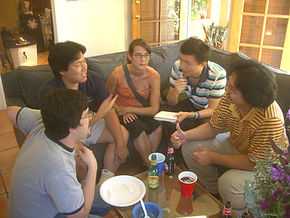Social psychology (psychology)/Tutorials/Cross-cultural training
< Social psychology (psychology) < Tutorials| | Resource type: this resource contains a tutorial or tutorial notes. |
| | Completion status: this resource is considered to be complete. |
Purpose
The purpose of this tutorial is to:
- Develop academic knowledge and experiential skills for developing effective behaviour in cross-cultural contexts (building on the communication tutorial and the relationships lecture);
- Explore culture shock and the stages of cultural adaptation
- Understand the process of cultural mapping
Equipment
- Name tags & markers
The story of my name

- Purpose
- This is an introductory cross-cultural communication exercise intended for exploration of one's cultural heritage and the cultural heritage of others (as represented by names).
- A second purpose of this exercise is to develop communication and presentation skills.
- Steps
- Ask participants to partner up with someone in the room whom they do not know very well (however, most students seem to prefer and be more comfortable doing this exercise with someone they know a bit).
- Ask students to interview one other about the "story of their name", e.g.,
- Find out about first, middle, and last names - also ask about nicknames and self-chosen names such as "screen names"; consider e.g.,
- What does each mean?
- Why was each chosen?
- What is the personal/family/cultural history behind each name?
- How do these names "work" in the "real world" - are there problems?
- Find out about first, middle, and last names - also ask about nicknames and self-chosen names such as "screen names"; consider e.g.,
- Allow ~15-20 minutes for the interviews (~5-10 mins each partner)
- Each person presents "the story behind their partner's name" to the whole group (helps to reinforce the [[Social psychology (psychology)/Tutorials/Tutorials/Communication|communication skills tutorial] - e.g., participants should clarify their understanding of the story behind their partner's name with their partner before presenting).
- Allow approx. 20 minutes for each person to share the story behind their partner's name (depends on size of group; ~1-2 mins per person introduced)
- Tutor writes names on a whiteboard (as they are introduced) - because often difficult names in particularly are not clearly pronounced and hence not clearly understood)
- See also: The story of my name
How Australian are you?
- In 2008, we tried asking people about their cultural identity and whilst somewhat revealing at times, most struggled to understand or describe what this might consist of for themselves.
- Thus, for future tutorials, an idea is to instead explore the question "How Australian are you?". Invite students to self-rate themelves on a 1-10 scale (1 = not very Australia; 10 = very Australia) and to plot their score on the whiteboard..
- Discuss why or why not different people consider themselves as having an "Australian identity". This would also help lead into the next tutorial on the "Australian Zeitgeist".
What is culture?
Purpose: This is an introductory exercise to explore the abstract concept of "culture" by "making it strange" or "defamiliarising" (ostranenie) and then trying to (re)build a shared understanding of what it is, at least from a social psychological perspective.
- Ask the class to define "culture"
- Note: Culture contains the word cult - ask what the difference is between cult and culture
- Concept map answers on the whiteboard
- Encourage the class to develop a tight, dictionary-like definition.

Additional activity: Cultural identity
Culture shock
- What is it? (define)
- Why does it occur?
- Who has experienced culture shock (or knows someone who has?) (ask for examples)
- What were the lead up circumstances?
- What were the symptoms? (consider Affect, Behaviour, and Cognition)
- What happened afterwards? How was it dealt with?
- How can it be dealt with, minimised or prevented? (this is dealt with in the next section)
| “ | The term culture shock is used to describe the emotional and physical discomfort a person suffers when moving to a completely new environment. Individuals often experience a lack of direction, a feeling of not knowing what to do or how to handle things, how to react and of not knowing what is (in-) appropriate. Culture shock is a natural and human response to new cultural experiences. | ” |
| “ | I feel different from everyone else. . . . I can't really be with anybody because people can't understand me, and I can't understand them. I feel it is hard for me to tell them all what I feel or express myself. So, I just keep my feelings inside. | ” |
| —(Immigrant child from Ukraine to Canada, age 12, personal communication) - (Maslennikova, 2003, accessed 19/09/2007 | ||
Cultural adaptation

- Ask students what phases might be involved in cultural adaptation:
- Culture shock doesn't come out of nowhere, and that it doesn't necessarily last. So, what is the process - what sorts of experiences does someone have in a new culture?
- Encourage students along these lines to see how much of the thinking behind the following stages of cultural adaptation they can generate (usually much of it).
- Present and discuss Winkelman's stages of cultural adaptation.
- Ask participants whether they can think of (and share) instances in their own lives (or the lives of others) when they've experienced at least some of the suggested stages of cultural adaptation.
- e.g., Fabrizio and Neill (2005) used Winkelman's stages of cultural adaptation to discuss the experience of going on a camp or outdoor education program.
Strategies for adaptation
- How can we help a person to culturally adapt?
- Consider what could be help someone adapt, as a warmup for the cultural mapping exercises
- Ask students to propose ideas about how to help someone adapt culturally?
- Scenario: Sarah has been to assigned to coordinate a 12 month social development program being operated by an international aid agency in a refugee camp in Africa.
- How could Sarah prepare to cope with the challenges of cultural adaptation that she might face?
Cultural mapping
Overview
The cultural mapping technique draws on experiential, learning, social-cognitive, group-based development theories, such as used in the EXCELL (Excellence in Experiential Learning and Leadership) cross-cultural competency training program (for more information, see the Sociocultural competencies lecture) which utilise these ABCD training steps:
- Alliance building and assessment: Participants are encouraged to explain how they would approach the specific task in their original culture and the underlying values for such behaviours.
- Cultural mapping: Generate a cultural map (with specific, micro-steps for how to perform the given task in the new culture) (with help from experts) . The cultural map is laid out in four stages of interactions, the ABCD model :
- Approach: Making initial contact
- Bridging: Building a relationship
- Commenting: Communicating the key message
- Developing/Closure: Closing and setting up next contact
- Demonstration and coaching: The trainers model the cultural competency by role-playing a practice scenario, and demonstrating the sequence of micro skills represented in the cultural map. Subsequent simulations are then encouraged from the participants, with the trainers providing corrective feedback and conducting re teaching where appropriate.
- Homework and review: Participants then find real life scenarios in which to practice their newly-learnt cultural skills, reporting back to the group about their experiences in the next session.
What is cultural mapping?
- A sociocultural training technique.
- A clear, simple, step-by-step description of one effective and appropriate way of behaving in a specific social situation, with explanation for why these behaviours are preferred.
- Involves making explicit the script for achieving tasks in socio-cultural settings with which one is unfamiliar, i.e., this explicit script can function as a 'map' for navigating new social territory.
- In particular, a cultural map makes explicit the usually unwritten, specific ways of competent behaving in a particular context.
- It is first necessary to define a skill or competency one wishes to perform in the unfamiliar culture, e.g., disagreeing with someone.
How to construct a cultural map
- It can be helpful to initially map how the competency is performed in a familiar culture setting. Then move on to map how it is performed in the new culture (according to what has been observed about the new culture and with the aid of cultural experts), e.g., "What do people who effectively disagree in culture x do?"? Include verbal and non-verbal responses, with examples.
- Break-down the behaviours into precise, observable, sequential steps which can be reproduced by an observer.
- It can be helpful to structure cultural maps using the ABCD model (Ishiyama, 1998)
- Attending
- Bridging
- Commenting
- Developing/Closing
- Other suggestions for constructing cultural maps
- Provide cultural explanations behind the behaviours, and compared with the cultural explanations of the learners.
- Provide alternative strategies and behaviours.
- Offered as one socially appropriate, context-specific way to navigate in the new culture, but not prescriptions to follow without question.
Demonstrating development of a cultural map
Demonstrate the process of cultural mapping using an example chosen by the class:
- Choose a cultural context and select a skill e.g.,
- an Australian university and asking a lecturer for help might be a familiar one
- how to approach and enter someone's house in Rwandan culture might be unfamiliar
- In in a novel culture, a cultural map can be helpful guide; just as a geographical map might be
helpful for getting around in an unfamiliar place.
|
Additional exercises: Cultural map development and Cultural map role-plays
Discussion
- Ask class for suggestions about the strengths and weaknesses of cultural mapping and thoughts about how it could be applied.
References
- The EXCELL Intercultural Skills Programme
- Fabrizio, S., & Neill, J. T. (2005). Cultural adaptation in outdoor programming. Australian Journal of Outdoor Education, 9(2), 44-56.
- Knott, V., Mak, A., & Neill, J. T. (2013). Teaching intercultural competencies in introductory psychology via reflection and application of the EXCELL model. Australian Journal of Psychology, 65(1), 46-53. doi:10.1111/ajpy.12008 | See also: Project website
- Mak, A. (2000). Extending social skills for success, 3-4.
- Mak, A. (in press). Embedding intercultural competence development in the health psychology curriculum. Psychology Learning and Teaching.
- Mak, A., Barker, M., Logan, *., & Millman, *. (1999). Benefits of cultural diversity.
- Mak, A. (2007). Sociocultural competencies: Lecture notes. University of Canberra.
- Winkelman, M. (1994). Cultural shock and adaptation. Journal of Counseling & Development, 73, 121-126.
See also
- Cultural identity
- Cultural map development
- Cultural map role-plays
- E-portfolio reflections on this tutorial e.g., Jenny O, JennaC, Mimosa Forsyth, Kim Crocker, Dskrzecz, Betsy, U3012675, Bel, Tim Malysiak, more
- Tutor notes
External links
ucspace
- Tutorial Cross-cultural training I (2007)
- Tutorial Cross-cultural training II (2007)
- Cross-cultural training tutorial (ucspace)
- Cross-cultural psychology (2007 overview)